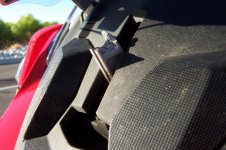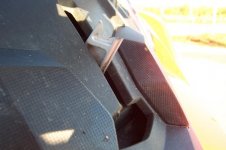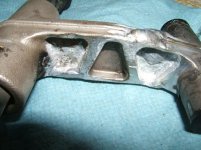CyncySpyder ,
On the smaller windshield and better MPG, I would say it is all drag related. The smaller windshield does not necessarily mean lower drag, it is just potentially reduces the overall surface area of the entire bike. I say potentially reduces the surface area. Keep in mind the rider/passenger and top back end of the bike are part of the surface area. You want the windshield to create an airflow over the rider but do so so it can come back together smoothly behind you causing it to miss the rider etc. If your windshield is too small, the airflow hits the rider, etc, and the surface area goes way up.
The drag force (Fd) is calculated from this equation:
1/2 is a constant
p is the density of the fluid; in our case it is air
v is the velocity
Cd is the coefficient of drag
A is the surface area
You clearly have reduced A, the surface area with the smaller windshield/overall bike. That leaves only 2 other variables, v and Cd. Assuming you are still traveling at the same overall average velocity, it is the Cd of the entire bike that is the same.
The Cd of the bike is influenced by the windshield; but that does not mean smaller is better. The Cd of a flat plate going into the wind is 1.28. Go look at your shorter windshield. If you run it in the upright position, I bet it is more upright - closer to the flat plate example. A slight bend running from left to right helps reduce the Cd, but it still is high. Take a look at the GL1800 windscreen. It is really tipped over + it is curved from side to side. This canted and curve surface really helps drop the Cd. It also helps the airflow as it it is smoother coming over the top and around the rider/passenger. When you run a more vertical surface it creates a lot of induced drag as the air is not smooth but it can create a pocket of still air behind it. Good for the rider but not so for the passenger as the air comes slamming in behind the rider and hits the passenger... As I look at the bike, I see lots of winged surfaces that shape the airflow. Many of them are placed to divert air to the side creating pockets (vacuum) spots to pull heat away. Examples inclued the small clear wings in front of the top vents and the lower black wings to divert air outward to help pull heat away and channel air to push water from the front wheels. They do that well enough, but they add lots of induced drag. Stick your arm out sideways and then canted them back 30 degrees and note the [air] force on your arm. Canting back arm helps reduce the drag, but there is still a lot. Thats what your black side air deflectors are doing, diverting air and creating drag. Speaking of which the fenders are something else. Look at them at highway speeds. The mud flap shakes side to side. Why, they act like big scoops even though the tire is in front of them. The force on them is so great, they shake. You can see how they changed the 2013/2014 fenders. The back is shorter and canted front and rear lips to help air flow out. They also removed the outside side lip so the overall fender assembly doesn't act like a scoop. And the mirrors, nice big surfaces sticking out in the airflow. Air management was not a high priority on this bike design. There are so many poor air management design decisions that contributes to high Cd and hence poor MPG. I will be spending some time to work on this since I am an aerospace engineer. My targeted areas are fenders, mirrors, underside of the bike, windshield, and small wings. I am confident measurable gains can be made. As I make changes, I'll post the results in a separate thread.
A side comment on cooling/drag. As I look at the 2014 Spyder, they changed the radiators by moving them forward and increasing the surface area. This change solved 2 documented problem areas, take the heat away from the right foot and increased the capacity of the cooling system. I just wish they implemented a reduced profile. Look at the front; 2 large scoops in the front = high drag. Using the bigger radiators, one on both sides, they should have tilted back both radiators over at a 30 degree angle. The scoops could be smaller and the exit flow would be down and under the bike. At slow speeds, the fans would easily pull in enough air flow and at speed there would be plenty of airflow. They still don't have aero engineers helping them clean up the bike.
Jerry




